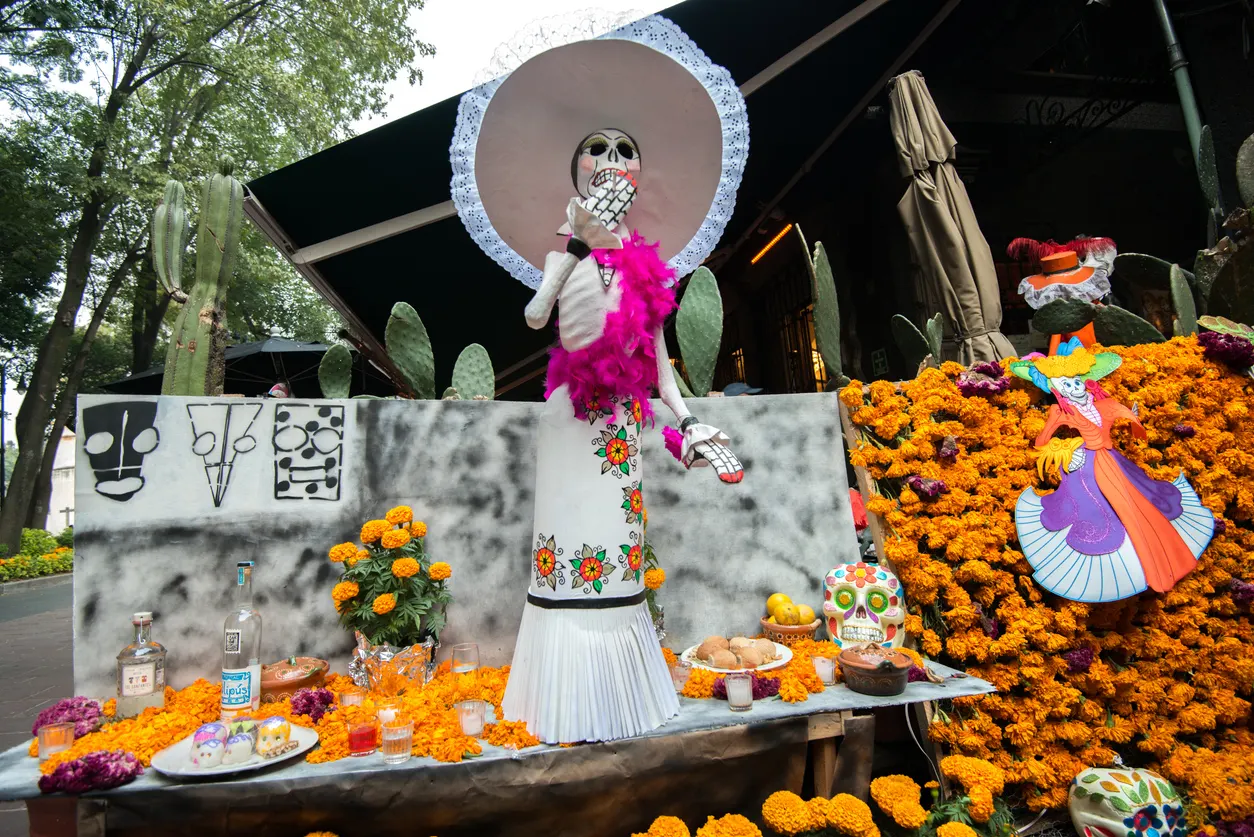
30 Oct Global Halloween Traditions: Celebrate the Spooky Season
Halloween may be most commonly associated with costumes, candy, and trick-or-treating in the United States, but countries around the world have their own unique ways of celebrating this spooky season. Many cultures observe traditions that blend honoring ancestors, warding off spirits, and celebrating the change in seasons. At Hickory Valley Retirement, we love learning about global customs, and Halloween offers a fantastic opportunity to explore international celebrations. Here’s a look at Halloween traditions around the globe and how different cultures embrace the season.
1. Mexico: Día de los Muertos (Day of the Dead)
Overview
Mexico’s Día de los Muertos, or Day of the Dead, is a beautiful and deeply spiritual celebration that honors deceased loved ones. Taking place from October 31 to November 2, this tradition combines Indigenous beliefs with Catholic customs, creating a vibrant festival that is both somber and joyful.
- Key Traditions: Families create colorful altars, or “ofrendas,” decorated with photos, candles, marigolds, and offerings like food, drinks, and sugar skulls. Parades, face painting, and traditional dances are also a big part of the celebration.
- Interesting Fact: In Mexico, death is seen as part of the natural cycle of life, and Día de los Muertos is a way of celebrating rather than fearing it.
2. Ireland and Scotland: Samhain
Overview
Halloween as we know it today has roots in the ancient Celtic festival of Samhain, which originated in Ireland and Scotland. Samhain marks the end of the harvest season and the beginning of winter, a time when the boundary between the physical world and the spirit world is believed to be at its thinnest.
- Key Traditions: Traditionally, people would light bonfires, wear costumes to ward off wandering spirits, and carve turnips (instead of pumpkins) to create lanterns.
- Modern Celebrations: While traditional Samhain customs are still honored in some parts, many Irish and Scottish people now celebrate Halloween with costumes, parties, and trick-or-treating, similar to the U.S.
3. Japan: Kawasaki Halloween Parade
Overview
Halloween has gained popularity in Japan over the past few decades, though it is celebrated in a more playful and festive way rather than as a traditional holiday. The Kawasaki Halloween Parade, held in late October, is one of the country’s biggest Halloween events, drawing thousands of participants in elaborate costumes.
- Key Traditions: Participants dress up in creative, sometimes spooky costumes and parade through the streets. Cosplay and intricate costumes are very popular, making this event a showcase of creativity.
- Unique Aspect: Unlike traditional Halloween celebrations, Japanese Halloween focuses more on the art of costume and community fun, with less emphasis on trick-or-treating.
4. Philippines: Pangangaluluwa
Overview
In the Philippines, the traditional celebration of Pangangaluluwa is observed on All Saints’ Day (November 1) and All Souls’ Day (November 2). This celebration blends indigenous customs with Catholic beliefs and involves honoring the deceased and praying for souls in purgatory.
- Key Traditions: In some regions, children go door-to-door singing songs or prayers for the souls of the departed, similar to Halloween caroling, and are often given food or small gifts in return.
- Modern Influence: Western Halloween traditions, such as costume parties and trick-or-treating, are also becoming popular, especially in urban areas.
5. Italy: All Saints’ Day and All Souls’ Day
Overview
In Italy, Halloween is a relatively recent import and is mainly celebrated by younger generations. However, the traditional All Saints’ Day (November 1) and All Souls’ Day (November 2) are widely observed. These days are dedicated to honoring saints and remembering the deceased.
- Key Traditions: Families visit cemeteries to place flowers on the graves of loved ones and light candles to honor their memories.
- Fun Fact: In some parts of Italy, people make and exchange small “soul cakes” as a way to commemorate the dead.
6. China: Teng Chieh (Hungry Ghost Festival)
Overview
Although not directly tied to Halloween, the Hungry Ghost Festival (or Teng Chieh) in China shares similar themes of honoring the dead and appeasing spirits. Celebrated in late summer (usually August), this festival is based on traditional Chinese beliefs about the afterlife.
- Key Traditions: Families offer food, incense, and money (often in the form of paper currency burned as an offering) to wandering spirits. Lanterns are lit to help guide lost souls back to the afterlife.
- Interesting Aspect: The festival centers around respecting and remembering the dead, with rituals intended to bring peace to both the living and the spirits.
7. Germany: All Saints’ Day and Halloween Celebrations
Overview
Halloween has gained popularity in Germany, especially in larger cities, with costume parties and decorations becoming more common each year. However, the traditional observance of All Saints’ Day on November 1 remains an important day for honoring deceased loved ones.
- Key Traditions: People celebrate Halloween with costume parties, pumpkin carving, and, in some areas, trick-or-treating. On All Saints’ Day, many people attend church services and visit cemeteries.
- Unique Aspect: Germany’s Halloween celebrations have a more reserved tone compared to the U.S., often blending elements of reverence with festive fun.
8. Sweden: Alla Helgons Dag
Overview
In Sweden, Alla Helgons Dag, or All Saints’ Day, is observed on the first Saturday of November. Although Halloween celebrations have recently become popular, particularly among young people, Alla Helgons Dag is more traditional and focused on remembering loved ones.
- Key Traditions: Families gather to light candles and place flowers on graves, creating beautiful displays of light at cemeteries across the country.
- Fun Fact: Halloween costumes and decorations are a newer phenomenon in Sweden, with young Swedes increasingly celebrating the American-style Halloween on October 31.
9. Romania: Dracula Tourism
Overview
Romania, home of the legendary Count Dracula, has naturally capitalized on Halloween as a time to celebrate its connection to the famous vampire. Although Halloween is not widely observed traditionally, Romania offers themed events that attract tourists interested in Dracula lore.
- Key Events: Special tours of Bran Castle, believed to be Dracula’s home, are offered around Halloween, along with costume parties and theatrical reenactments of the Dracula legend.
- Interesting Twist: For those seeking a unique Halloween experience, Romania’s Dracula-themed festivities provide a spooky, historically rich adventure.
A Global Perspective on Halloween
Halloween and other similar celebrations around the world show us how various cultures honor the dead, welcome the changing seasons, and indulge in a bit of spooky fun. Whether it’s with parades, festivals, rituals, or simply spending time with loved ones, these traditions remind us of the beauty of remembering and celebrating life’s cycles. At Hickory Valley Retirement, we love exploring global traditions with our residents, appreciating the similarities and unique aspects of each culture’s approach to this mysterious and festive season.





